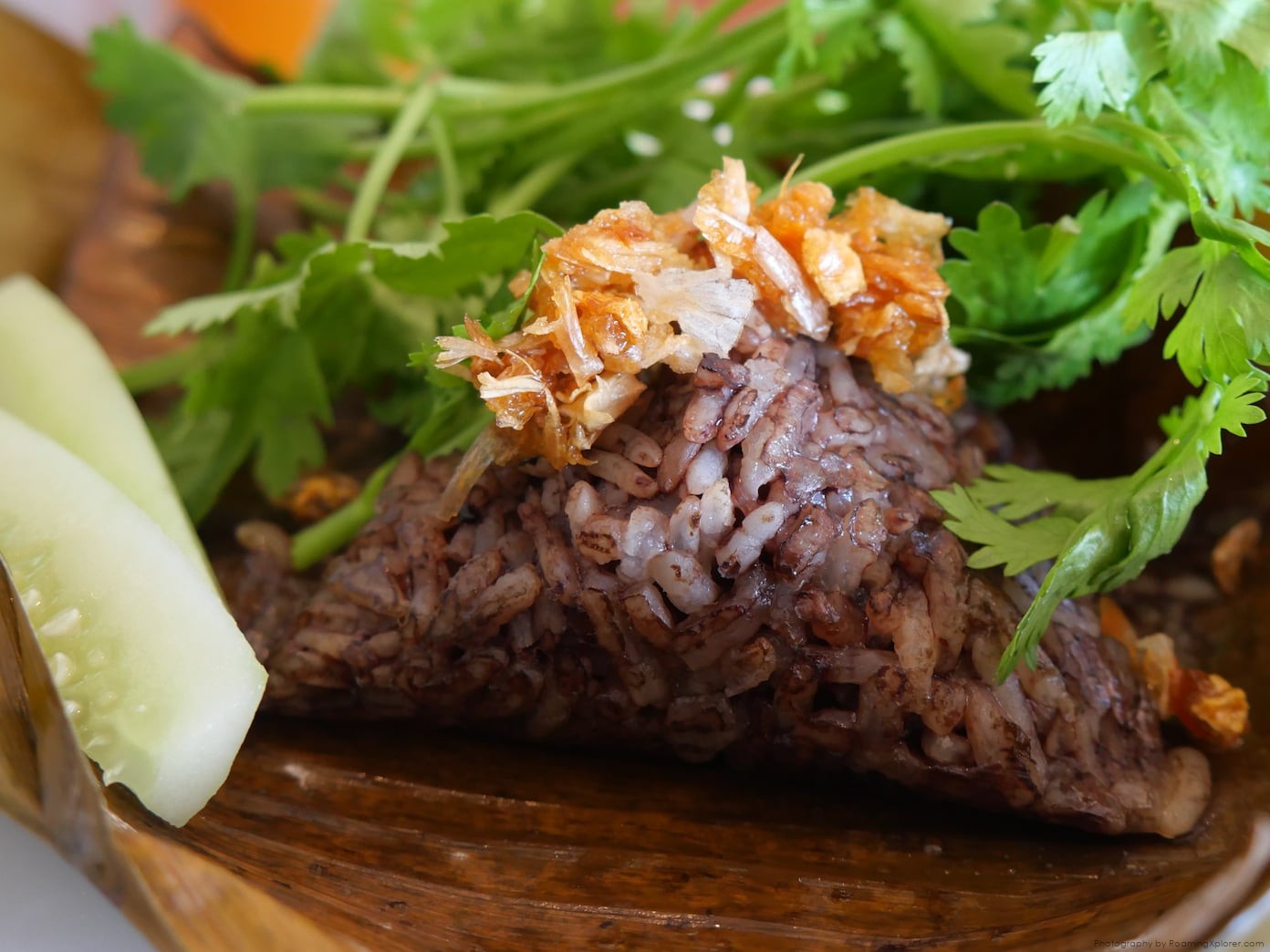A Journey Through Taste and Tradition
When you travel through Northern Thailand, every dish tells a story. Some speak of mountain communities and ancient trade routes; others whisper tales of migration and identity. Among these culinary narratives, Khao Kan Chin, also known as Khao Ngeow or “Shan-style blood rice,” stands out as a humble yet fascinating reflection of cultural fusion and timeless taste.
During my journey through Chiang Rai, I encountered this dish for the first time, neatly wrapped in a green banana leaf, its aroma subtle yet inviting. One bite was enough to transport me deep into the heart of Lanna’s history, revealing flavors shaped by generations of Northern Thai and Shan people.
The Origins: A Taste Rooted in the Shan Heritage
To understand Khao Kan Chin, one must travel back in time to the era when the Tai Yai or Shan people migrated across the borderlands between Northern Thailand and Myanmar’s Shan State. The Shan people, renowned for their refined culinary traditions, brought with them a variety of rice-based dishes that relied on simple, accessible ingredients.
In the Shan language, “Kan” means to mix or knead, and “Chin” means meat. Thus, Khao Kan Chin literally translates to rice mixed with meat. The dish was traditionally prepared with minced pork or beef, fresh animal blood, and fragrant rice, all of which were kneaded together before being wrapped in banana leaves and steamed.
Over time, the dish became an integral part of Northern Thai cuisine, particularly in Chiang Rai, Mae Hong Son, and Chiang Mai, where the Shan and Lanna cultures have coexisted for centuries. Locals often refer to it as Khao Ngeow, derived from the historical name for the Shan people, although modern sensibilities encourage the use of Khao Kan Chin instead.
From Hill Villages to City Markets
Historically, Khao Kan Chin was more than a meal. It was a portable provision. Shan villagers, who lived in remote mountainous areas, needed food that could be easily stored, carried, and eaten during long journeys or while working in the fields. Wrapping the rice mixture in banana leaves and steaming it created a self-contained meal that stayed moist and flavorful for hours.
As migration patterns shifted and urban markets grew, Khao Kan Chin found its way into Northern Thai morning markets and temple fairs. Today, you can still find it sold in bundles at local markets in Chiang Rai or Mae Hong Son, often displayed beside baskets of sticky rice, grilled meats, and chili dips. Yet, it remains a rare gem for travelers unfamiliar with Northern Thai street food.
Traditional Preparation: A Ritual of Balance
The charm of Khao Kan Chin lies in its simplicity, as well as in the precise balance of textures and flavors. Traditional cooks often describe the preparation as a meditative process that requires patience, intuition, and a deep respect for the ingredients.
1. The Rice
Unlike most Northern Thai dishes that rely on sticky rice, Khao Kan Chin uses jasmine rice (known locally as khao chao). The grains are cooked until tender yet firm, ensuring they remain separate after mixing.
2. The Meat and Blood
Minced pork is the most common choice today, though earlier generations often used beef. Fresh pig’s blood is added to the mixture, a traditional method of enriching the rice with a deep, savory aroma and earthy flavor. The blood acts as a natural binding agent, giving the rice its distinctive reddish brown hue after it is steamed.
3. The Flavor Base
Crushed garlic, shallots, fish sauce, salt, and white pepper are added to season the mixture. Some cooks include a touch of sugar to balance the saltiness, while others add boiled pork fat or crispy pork cracklings (kap moo) for extra richness.
4. The Kneading (“Kan”)
This step gives the dish its name. The rice, meat, and blood are thoroughly kneaded by hand not merely stirred until every grain of rice absorbs the flavor and color evenly. The tactile process is said to connect the cook to the food, infusing it with care and intention.
5. The Wrapping and Steaming
The seasoned mixture is portioned into banana leaves, shaped into compact rectangles, and secured with thin bamboo sticks. The wrapped parcels are then steamed for about 30 minutes, allowing the banana leaf to infuse the rice with a faint herbal aroma.
6. The Garnish
When ready to serve, the parcels are unwrapped to reveal a reddish, glistening rice cake. The dish is topped with golden fried garlic, crispy pork cracklings, sliced shallots, coriander, and dried chili flakes, a perfect contrast of colors and textures.
A Symphony of Flavors and Textures
The first bite of Khao Kan Chin is a sensory revelation. The rice is moist yet firm, carrying a delicate aroma from the banana leaf. The flavor is savory and slightly metallic, not unpleasantly so, but with the subtle richness of iron from the blood. The garlic and shallots bring warmth, while the pork adds substance. A sprinkle of fried garlic and cracklings delivers that irresistible crunch, balancing the softness of the rice.
What makes the experience unique is the harmony: every element, though simple on its own, comes together to create a taste both comforting and mysterious. Pairing it with cool cucumber slices or fresh herbs enhances the freshness, cutting through the richness of the rice.
Cultural Significance: A Dish of Identity and Memory
In Northern Thai food culture, Khao Kan Chin represents more than sustenance; it’s a symbol of community and identity. Among Shan families, it was often prepared during family gatherings, temple merit-making ceremonies, and seasonal festivals. Sharing Khao Kan Chin was seen as an act of unity, a reminder of home, even for those who migrated across borders.
For locals, the dish bridges two culinary traditions: Lanna and Shan. It embodies the openness of Northern Thai cuisine, which welcomes diverse influences, such as Burmese spices, Chinese noodles, Shan rice, and herbs from hill tribes, while maintaining its own distinct character.
In many ways, Khao Kan Chin is a story of coexistence told through food. Each parcel is a small emblem of cultural blending, carried forward through taste and memory.
Modern Adaptations and Evolving Perceptions
While Khao Kan Chin remains a beloved dish among locals, it is still relatively unknown to visitors. Part of this lies in its main ingredient, animal blood, which can be intimidating to some. However, modern cooks and chefs are reinterpreting the dish with lighter versions that retain its spirit without the intensity.
In some Chiang Rai cafés and boutique restaurants, you’ll find creative spins such as:
- Vegetarian Khao Kan Chin, using mushroom paste or red rice instead of meat and blood.
- Fusion versions, served with spicy dipping sauces or crisp vegetables for contrast.
- Deconstructed plates, where the rice, meat, and condiments are served separately for modern presentation.
These contemporary takes help preserve the dish’s cultural story while making it more approachable for new audiences.
Experiencing Khao Kan Chin in Chiang Rai
During my first encounter with Khao Kan Chin in Chiang Rai, I had it for breakfast at the hotel where I stayed. I unwrapped a steaming banana parcel, and the aroma of garlic and pork fat wafted into the cool morning air.
They served it with fresh cucumber, cilantro, fried garlic, and a sprinkle of chili flakes. The rice glistened in shades of brown and red, humble yet beautiful. As I took my first bite, I was struck not only by the flavor but by the sense of connection. It felt like eating history, a dish that had journeyed across generations to reach my plate.
For travelers, this is the kind of discovery that makes food storytelling so rewarding. Khao Kan Chin might not be the most photogenic dish, but it is deeply evocative, a living link to the region’s cultural tapestry.
Where to Try Khao Kan Chin in Northern Thailand
If you’re planning a food adventure in Northern Thailand, here are a few places where you can still find authentic Khao Kan Chin:
- Chiang Rai Morning Market (Kad Luang) – Visit early in the morning for freshly steamed parcels sold by Shan vendors.
- Mae Hong Son Local Markets – Home to a large Shan community; the dish is often sold during temple fairs.
- Traditional Lanna Food Stalls in Chiang Mai’s Warorot Market – Occasionally feature Khao Kan Chin among other regional specialties.
- Community-run Homestays – In Shan villages near the Thai-Myanmar border, guests are sometimes invited to learn the cooking process firsthand.
When trying it, remember to enjoy it the local way, with fingers or a small spoon, alongside cucumber slices, pickled vegetables, and strong black tea.
Reflections: When Food Becomes a Journey
What fascinates me most about Khao Kan Chin is how something so simple can carry such profound meaning. In a world where food trends come and go, this humble banana-leaf parcel stands quietly as a reminder of heritage, migration, and resilience.
Tasting Khao Kan Chin in Chiang Rai was more than trying a new dish; it was a lesson in cultural storytelling. It reminded me that true travel isn’t just about seeing places, but about tasting their histories, feeling their rhythms, and carrying their stories forward.
For every traveler seeking authenticity, this is a dish worth discovering, one that invites you not only to eat but also to understand.
Because sometimes, the most extraordinary journeys begin with the simplest bites.
![]()

